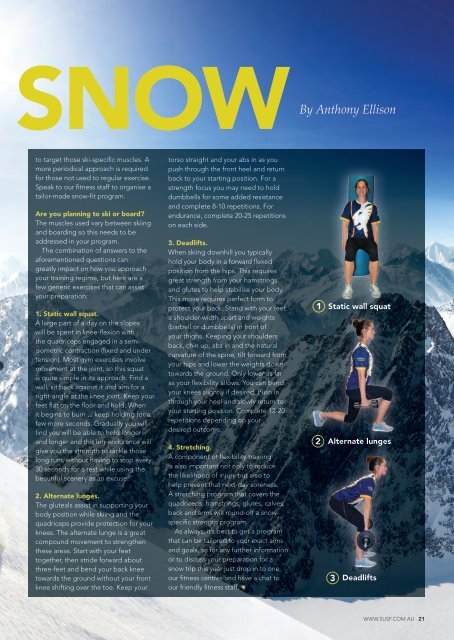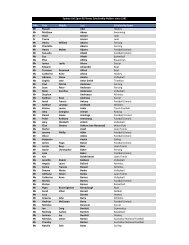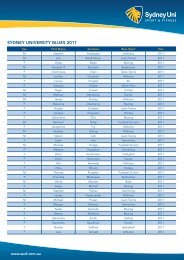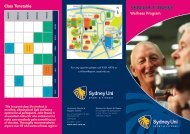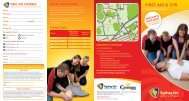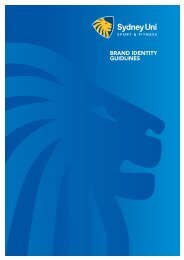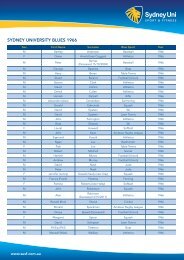To View - Sydney University Sport
To View - Sydney University Sport
To View - Sydney University Sport
Create successful ePaper yourself
Turn your PDF publications into a flip-book with our unique Google optimized e-Paper software.
snowByAnthony Ellisonto target those ski-specific muscles. Amore periodical approach is requiredfor those not used to regular exercise.Speak to our fitness staff to organise atailor-made snow-fit program.Are you planning to ski or board?The muscles used vary between skiingand boarding so this needs to beaddressed in your program.The combination of answers to theaforementioned questions cangreatly impact on how you approachyour training regime, but here are afew generic exercises that can assistyour preparation:1. Static wall squat.A large part of a day on the slopeswill be spent in knee-flexion withthe quadriceps engaged in a semiisometriccontraction (fixed and undertension). Most gym exercises involvemovement at the joint, so this squatis quite simple in its approach. Find awall, sit back against it and aim for aright-angle at the knee joint. Keep yourfeet flat on the floor and hold. Whenit begins to burn ... keep holding for afew more seconds. Gradually you willfind you will be able to hold longerand longer and this leg endurance willgive you the strength to tackle thoselong runs without having to stop every30 seconds for a rest while using thebeautiful scenery as an excuse.2. Alternate lunges.The gluteals assist in supporting yourbody position while skiing and thequadriceps provide protection for yourknees. The alternate lunge is a greatcompound movement to strengthenthese areas. Start with your feettogether, then stride forward aboutthree-feet and bend your back kneetowards the ground without your frontknee shifting over the toe. Keep yourtorso straight and your abs in as youpush through the front heel and returnback to your starting position. For astrength focus you may need to holddumbbells for some added resistanceand complete 8-10 repetitions. Forendurance, complete 20-25 repetitionson each side.3. Deadlifts.When skiing downhill you typicallyhold your body in a forward flexedposition from the hips. This requiresgreat strength from your hamstringsand glutes to help stabilise your body.This move requires perfect form toprotect your back. Stand with your feeta shoulder-width apart and weights(barbell or dumbbells) in front ofyour thighs. Keeping your shouldersback, chin up, abs in and the naturalcurvature of the spine, tilt forward fromyour hips and lower the weights downtowards the ground. Only lower as faras your flexibility allows. You can bendyour knees slightly if desired. Push inthrough your heel and slowly return toyour starting position. Complete 12-20repetitions depending on yourdesired outcome.4. Stretching.A component of flexibility trainingis also important not only to reducethe likelihood of injury but also tohelp prevent that next-day soreness.A stretching program that covers thequadriceps, hamstrings, glutes, calves,back and arms will round-off a snowspecificstrength program.As always, it’s best to get a programthat can be tailored to your exact aimsand goals, so for any further informationor to discuss your preparation for asnow trip this year just drop in to oneour fitness centres and have a chat toour friendly fitness staff.12Static wall squatAlternate lunges3 DeadliftsWWW.SUSF.COM.AU 21


